Your cart is currently empty!
Tag: Victorian what and what and what needs to be what and what and what?
How exactly did the oddly shaped British Victorian cutlery work?
How exactly did the oddly shaped British Victorian cutlery work?
Do a search for “silverware” and you’re sure to see a lot of strange objects – berry spoons, strawberry spatulas, harpoons …… – that seem to get the point, but how do you use them?
Why did people invent these many strange and weird tableware? Editor Sherlock Holmes on the body, finally found most of the answers in the Victorian period ……
Victorian what and what and what needs to be what and what and what?
When it comes to the tableware on the head of the thought of the place, the Victorian period (1837 ~ 1901) dare to call the five thousand years of the second “work”, I am afraid there is not too much objection to compete for the first.
That was the time when the “English table manners”, which were highly praised by later generations, were gradually taking shape, and the types and quantities of cutlery came along with it, sometimes using dozens or even hundreds of cutlery for a banquet.
However, after more than a hundred years, some of these dishes have lost their “context” and become more and more “unbelievable” ……

Pic: What is this and what is this? 丨Picture from the Internet
Harpoon – more occasions more choices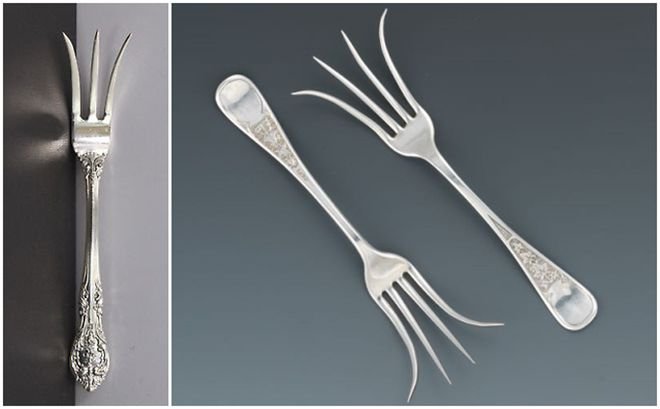
Picture: Lemon fish Fork, Lemon Fork (left)Lettuce ForkLettuce Fork (right)丨Picture from the network
They look pretty much the same, don’t they? But there’s a big difference: the lemon fork’s open tines are designed to pierce lemon zest, and are said to be commonly used when drinking tea (you’ve heard of the Brits’ love of tea, huh?); while the lettuce fork is larger and can be used to pierce those tough lettuce leaves. ); while the lettuce fork is larger and can be used to pierce those tough lettuce leaves.

Figure: Joint Fork (left) Potato Fork (right) 丨 ⧏35⧐ figure from the web ⧏34⧐
Some harpoons serve primarily as immobilizers.
How can a lady or a gentleman stand the embarrassment of meat sliding around on the plate when a joint fork, for example, is used to hold the meat in place while slicing? The swirling tines on the potato fork make potatoes less likely to fall off, thus avoiding a bad moment at the table (ohh……).
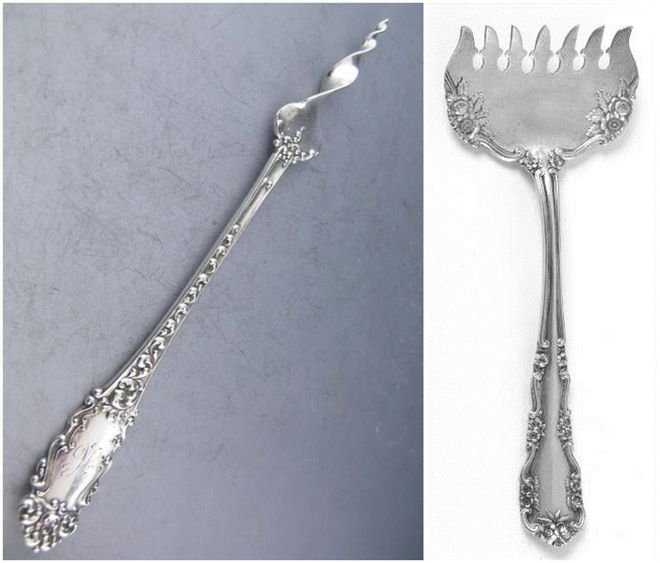
Picture: Butter Pick (left) Canned Fish/Sardine Fork Sardine Fork (right) 丨Picture from the Internet
Some harpoons are designed for easy access to food. Stylized rotary butter picks can take butter kept in a bucket or jar, wring it out smoothly, and then style it on the fly: it’s said that wrung butter looks like beautiful curls, and it’s pretty to think about when you put it on ice; the same goes for sardine forks, which allow one to more elegantly take greasy fish out of the can ……
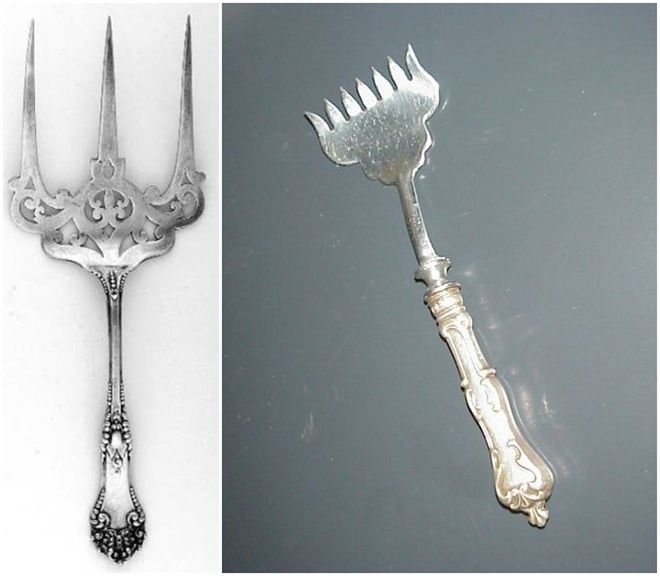
Picture: Toast Fork (left) Bacon Fork (right) 丨Picture from the network
If those introduced earlier are still somewhat practical, some of the “work” is a bit inexplicable – the left picture of the fork out of a piece of toast bread (and the difference between the ordinary fork really do not see), and the right picture and the sardine fork basically looks no different, but it is a bacon fork. But it is a bacon fork ……
Spoon – More Ingredients More StageHow can a single harpoon with different functions be enough, too “simple and crude”, the sophisticated Victorianers tell you – the spoon must also have a pattern!
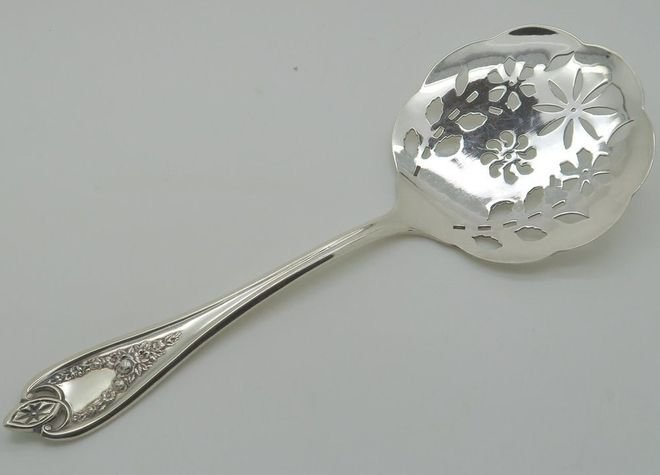
Picture: Thinly Sliced Tomato Spoon Tomato Server丨Picture from the Internet
Specializing in scooping thinly sliced tomatoes, the hollowed out pattern allows excess juice to escape, oh wow, I have to bow my poor head in admiration ……
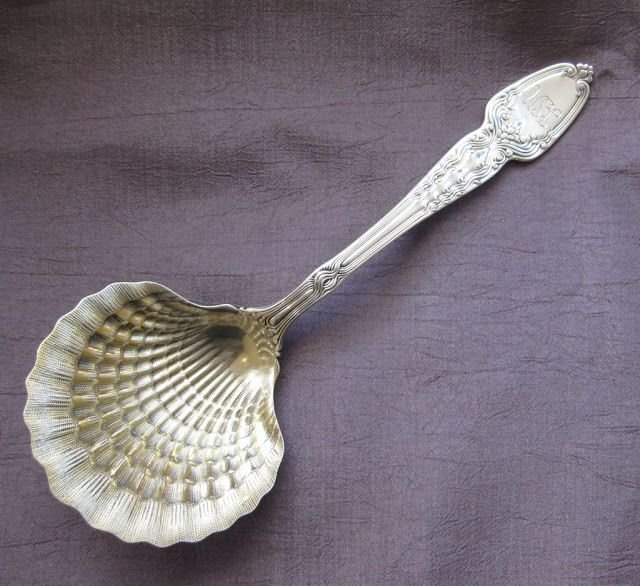
Picture:Berry Spoon丨Picture from the Internet
This spoon specializing in scooping blueberries and other small fruits, of course, usually the value of the spoon itself must be high, exquisite pattern must be arranged; because small fruits do not have juice leakage, so do not worry about not good to wash …… However, adhering to the “one kind of fruit needs to be matched with a kind of tableware However, adhering to the “a fruit needs to be accompanied by a kind of tableware,” the rigorous spirit of the Victoria er, strawberries must also have their own “small followers” —

Product Image: 19th Century Strawberry Spade丨Picture from bagpipe art e-commerce platform
There are some scoops that specialize in hard things, such as the fluent alignment on the sides of the cheese scoop that facilitates scooping cheese out of hard cheeses, and the jagged shape of the ice cream scoop that makes digging into frozen custard easier.
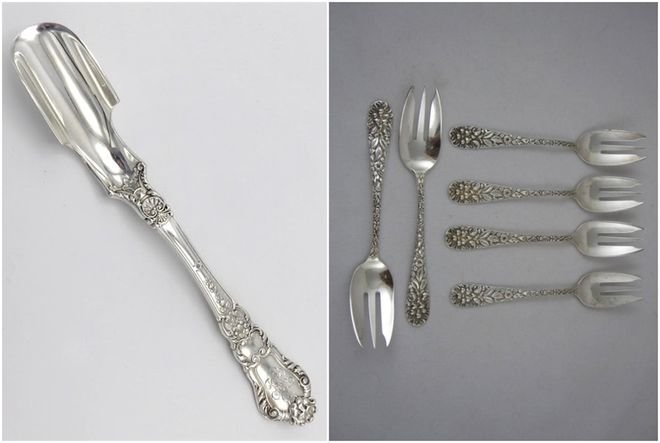
Picture: Cheese Scoop (left) Ice Cream Forks (right) 丨Picture from the Internet
By the way, before the ice cream scoop was invented in 1897, people used an Ice Cream Slicer to make “ice cream” (pre-1897 ice cream mentality).
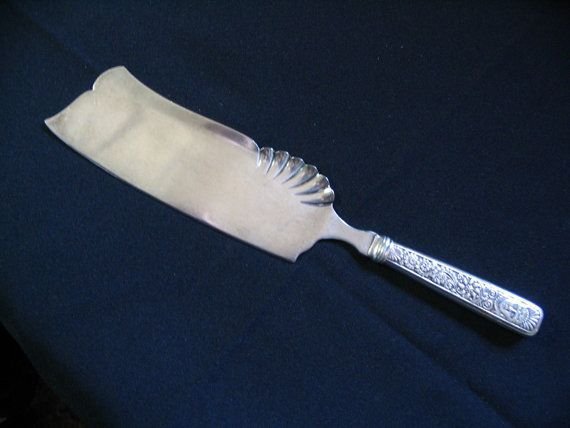
Ice Cream Slicer丨Picture from the web
There are spoons that can be used exclusively by the British. In their day, people mixed gelatin with meat, poultry, fish, eggs, and other ingredients to make jellies, allowing the gelatin to stop the food from coming into contact with air. The spoon for eating this jiggly, rah-rah stuff would have to look like a knife and a spoon, be able to cut and bear, and by the way, it would be ……real convenient to poke and dig for solid food ……real in the meat jelly with the tip of the spoon. By the way, sterling silver cutlery is also said to protect against a bacteria or something – technology is not developed, use cutlery to make up for it (how to think of a silver needle to test for poison ……).
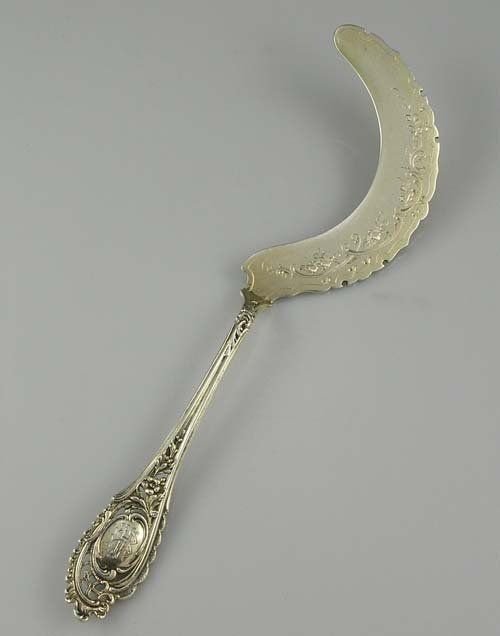
Picture: Meat Jelly Spoon Aspic Spoon丨Picture from the Internet
The unthinkable is here ……

Picture: Cake comb丨Picture from the Internet
Cake needs a “hairbrush” too? After careful research, I found that this is very practical – insert the sharp teeth into the desired cutting position, and then gently rock back and forth to separate the cake, eek, seems to be much more elegant than using a cake knife to poke around!

Picture:Food PusherBaby Food Pusher丨Picture from the Internet
This thing is not for the Second Brother, it is a “food pusher” for children – a pusher and spoon to help them easily push food onto their plates. …… Well, it’s true! It’s a Victorian er, table manners start with children!
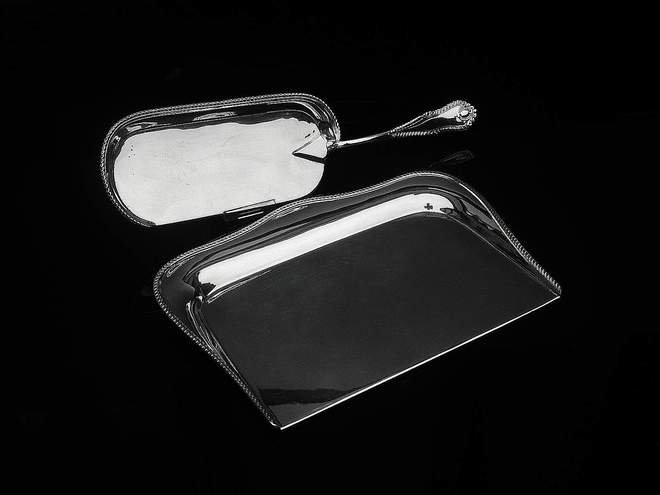
Picture:Crumb Scoop And Tray丨Picture from the Internet
This is a pizza spatula? NONONO, it’s a crumb spatula… In the 1850’s, servants used it to clean up bread crumbs and salad drippings from the dinner table… it seemed more elegant than using a dustpan and broom or a rag… (It’s amazing that servants had to be elegant to clean up the dinner table!)
In fact, these are only the tip of the iceberg of the Victorian silver tableware, there are spoon heaters, grape shears Grape Scissors, Knife Rest, Caddy Spoons Caddy Spoons …… limited to space (too much) really do not have the opportunity to appear. I picked up the chopsticks in my hands, can not help but fall into thought, why do people have to eat their fill of invention of so many cumbersome work on the sky, but it is indeed beautiful and good to see want to buy home to appreciate the tableware?
Do you have a lot of question marks, kids? Let me tell you ……
Actually, specialized yet targeted tools do work well!
In the experience of Kat Kinsman, antique flatware enthusiast and editor-in-chief of CNN’s food blog, her spoon with its wide, deep, curved bottom can be tilted to spread soup every time you have it, and the notch in the spoon filters out excess oil, so don’t be too fabulous for someone who is a stickler for good eating and a lot of demands.
In addition, it is true that there are some tableware that seem to be dispensable nowadays, but were very much in use at particular times in history. For example, sugar holders. During the Victorian period, sugar was a precious commodity, and those who had it would keep it in a locked sugar chest, the key to which could only be held by the hostess. Whenever tea was served or other occasions when sugar was used, the hostess used special little holders to distribute rare sugar cubes to her guests. While sugar cubes are common nowadays, silver sugar clips have become a special style of “elegant hostess afternoon tea” with a strong vintage flavor.

Photo: 19th Century Sugar Sprinkles and Sugar Clips Two-Piece Set 丨Picture from Bagpipe Art e-commerce platform
Moreover, no matter what time and place, the table is the most important social occasions, table utensils on the table all about the table host and the identity and status of the invitees.
Louis XV’s dinner table, there has been a solid gold “treasure ship”, which is loaded with spoons, napkins, salt shakers, test horn ……, Louis XV himself does not use, it has become a kind of ritual. Even if the king is not present, as long as you see the “boat”, men have to take off their hats, women also have to bow.
Not to mention the fancy assorted food boxes, napkins, candlesticks, baskets, and glazed chandeliers …… all serving to show off the king’s majesty.
Britain’s “dining style” was relatively recent, but the technique of elevating tableware to a status symbol was used with ease. In the Victorian era, when the British Empire reigned supreme around the world, this trend naturally became more and more intense.
It is attested that dinner parties of the time often included a minimum of twelve or more courses.
Imagine: each person’s cheese, fish, fruit, steak, chicken steak, lamb stew …… has to be accompanied by a different set of cutlery, each with its own butter knife, salt shaker, salt dish, and seasonal game utensils …… the table indicates, okay?
What’s even more interesting is that this “unspoken rule of ZZ at the table” exists in every culture.
Wine lecturer Qi Shaoren said than a decade ago in France, today’s table can be much more simple, even the traditional French aristocratic families, no longer to tableware to show off their wealth, “instead of the banquet on the main chef’s loud name and all over the air transported over the rare seasonal ingredients.”
Nicolas Defrémont, who has been serving in the hotel world for many years, has switched things up by having his staff replace the appropriate specialized tableware at the right time, depending on what the guest has ordered (tableware-choice-phobes can breathe a sigh of relief). After all, more than the so-called dining etiquette, attentive service is the core competence of the restaurant.
And Arthu rInchInch, a consultant on the movie Gosford Hall, said, “Such over-the-top Victorian table furnishings, from chocolates spoons for drinking to eight different styles of special forks for broccoli, are a phenomenon of the middle class only.” — Rumored to be rarely used by royalty, a question mark that I can’t answer ……
The bagpipes say
I’m sure you’ll say, isn’t the cutlery for the food? It’s the good food that counts, right?
Putting aside the element of social bragging, perhaps we can understand that in a particular context, abundant ingredients = enough spending power; exquisite tableware for each ingredient = both taste and sophistication; and a full complement of tableware for each guest = recognition and respect.
By the way, these complicated tableware sometimes have unexpected effects – according to legend, the French Bishop Richelieu once at the banquet table to reveal the true face of a liar, because he ate olives with a dinner fork, a farcical half will not use complicated tableware there is such an effect … … …
Some information collated from the Internet
Part of the picture from the network, infringement and deletion
Written by: Read | Edited by: Fuguer
Bagpipe Introduction:
Do a search for “silverware” and you’re sure to see a lot of strange objects – berry spoons, strawberry spatulas, harpoons …… – that seem to get the point, but how do you use them?
Why did people invent these many strange and weird tableware? Editor Sherlock Holmes on the body, finally found most of the answers in the Victorian period ……
Victorian what and what and what needs to be what and what and what?
When it comes to the tableware on the head of the thought of the place, the Victorian period (1837 ~ 1901) dare to call the five thousand years of the second “work”, I am afraid there is not too much objection to compete for the first.
That was the time when the “English table manners”, which were highly praised by later generations, were gradually taking shape, and the types and quantities of cutlery came along with it, sometimes using dozens or even hundreds of cutlery for a banquet.
However, after more than a hundred years, some of these dishes have lost their “context” and become more and more “unbelievable” ……
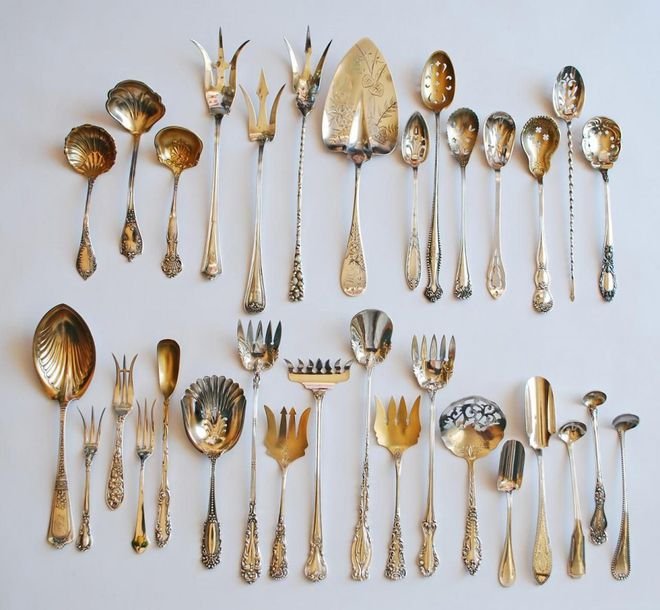
Pic: What is this and what is this? 丨Picture from the Internet
Forks – more occasions more choices
Picture: Lemon ForkLemon Fork (left)Lettuce ForkLettuce Fork (right)丨Picture from the network
They look pretty much the same, don’t they? But there’s a big difference: the lemon fork’s open tines are designed to pierce lemon zest, and are said to be commonly used when drinking tea (you’ve heard of the Brits’ love of tea, huh?); while the lettuce fork is larger and can be used to pierce those tough lettuce leaves. ); while the lettuce fork is larger and can be used to pierce those tough lettuce leaves.
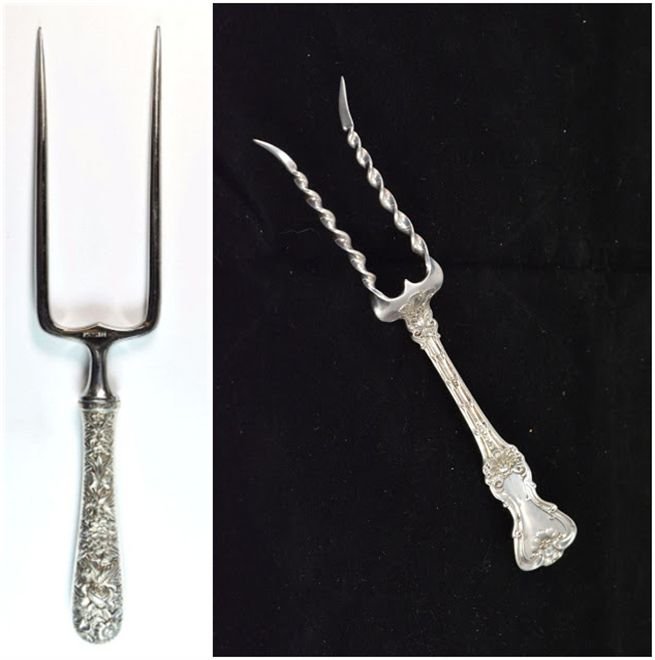
Figure: Joint Fork (left) Potato Fork (right) 丨 ⧏35⧐ figure from the web ⧏34⧐
Some harpoons serve primarily as immobilizers.
How can a lady or a gentleman stand the embarrassment of meat sliding around on the plate when a joint fork, for example, is used to hold the meat in place while slicing? The swirling tines on the potato fork make potatoes less likely to fall off, thus avoiding a bad moment at the table (ohh……).
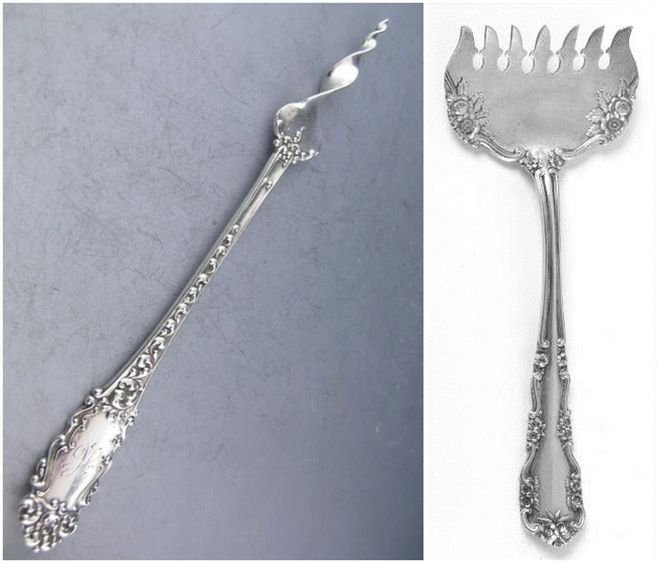
Picture: Butter Pick (left) Canned Fish/Sardine Fork Sardine Fork (right) 丨Picture from the Internet
Some harpoons are designed for easy access to food. Stylized rotary butter picks can take butter kept in a bucket or jar, wring it out smoothly, and then style it on the fly: it’s said that wrung butter looks like beautiful curls, and it’s pretty to think about when you put it on ice; the same goes for sardine forks, which allow one to more elegantly take greasy fish out of the can ……

Picture: Toast Fork (left) Bacon Fork (right) 丨Picture from the network
If those introduced earlier are still somewhat practical, some of the “work” is a bit inexplicable – the left picture of the fork out of a piece of toast bread (and the difference between the ordinary fork really do not see), and the right picture and the sardine fork basically looks no different, but it is a bacon fork. But it is a bacon fork ……
Spoon – More Ingredients More StageHow can a single harpoon with different functions be enough, too “simple and crude”, the sophisticated Victorianers tell you – the spoon must also have a pattern!
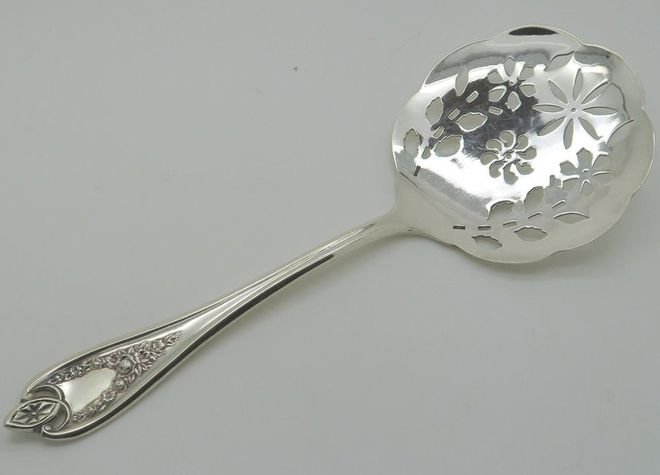
Picture: Thinly Sliced Tomato Spoon Tomato Server丨Picture from the Internet
Specializing in scooping thinly sliced tomatoes, the hollowed out pattern allows excess juice to escape, oh wow, I have to bow my poor head in admiration ……
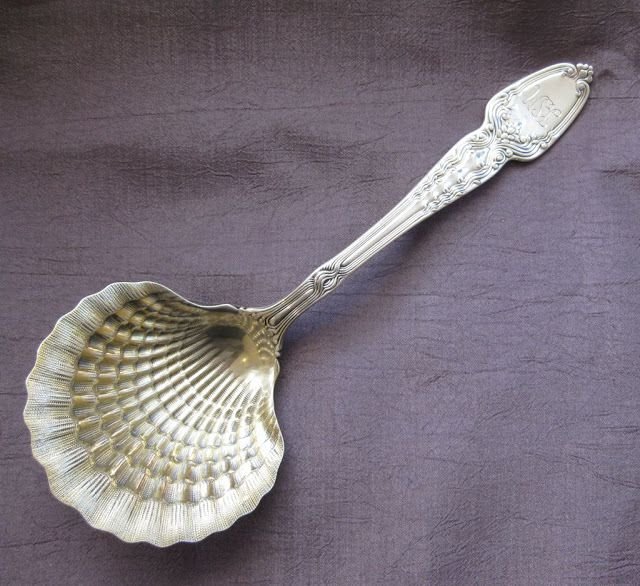
Picture:Berry Spoon丨Picture from the Internet
This spoon specializing in scooping blueberries and other small fruits, of course, usually the value of the spoon itself must be high, exquisite pattern must be arranged; because small fruits do not have juice leakage, so do not worry about not good to wash …… However, adhering to the “one kind of fruit needs to be matched with a kind of tableware However, adhering to the “a fruit needs to be accompanied by a kind of tableware,” the rigorous spirit of the Victoria er, strawberries must also have their own “small followers” —
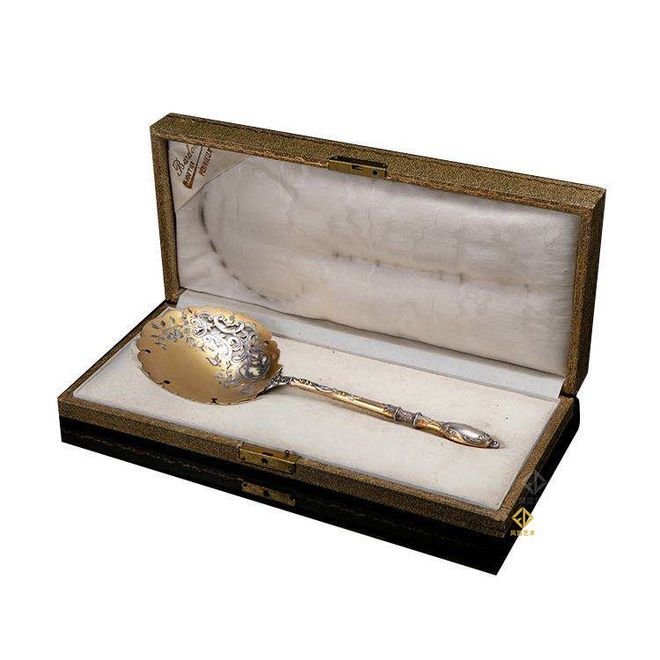
Product Image: 19th Century Strawberry Spade丨Picture from bagpipe art e-commerce platform
There are some scoops that specialize in hard things, such as the fluent alignment on the sides of the cheese scoop that facilitates scooping cheese out of hard cheeses, and the jagged shape of the ice cream scoop that makes digging into frozen custard easier.

Picture: Cheese Scoop (left) Ice Cream Forks (right) 丨Picture from the Internet
By the way, before the ice cream scoop was invented in 1897, people used an Ice Cream Slicer to make “ice cream” (pre-1897 ice cream mentality).

Ice Cream Slicer丨Picture from the web
There are spoons that can be used exclusively by the British. In their day, people mixed gelatin with meat, poultry, fish, eggs, and other ingredients to make jellies, allowing the gelatin to stop the food from coming into contact with air. The spoon for eating this jiggly, rah-rah stuff would have to look like a knife and a spoon, be able to cut and bear, and by the way, it would be ……real convenient to poke and dig for solid food ……real in the meat jelly with the tip of the spoon. By the way, sterling silver cutlery is also said to protect against a bacteria or something – technology is not developed, use cutlery to make up for it (how to think of a silver needle to test for poison ……).

Picture: Meat Jelly Spoon Aspic Spoon丨Picture from the Internet
The unthinkable is here ……
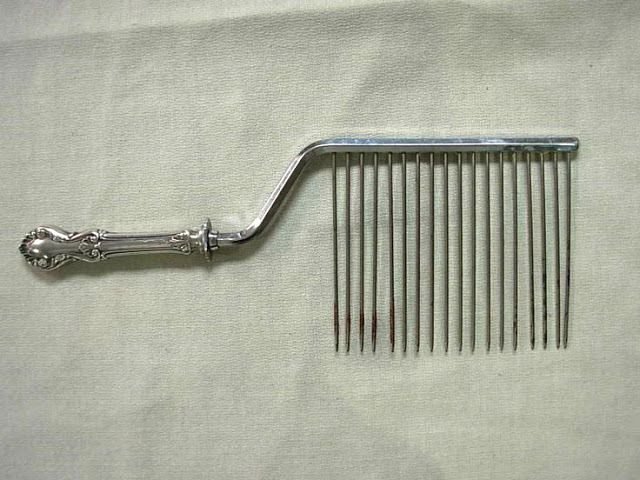
Picture: Cake comb丨Picture from the Internet
Cake needs a “hairbrush” too? After careful research, I found that this is very practical – insert the sharp teeth into the desired cutting position, and then gently rock back and forth to separate the cake, eek, seems to be much more elegant than using a cake knife to poke around!
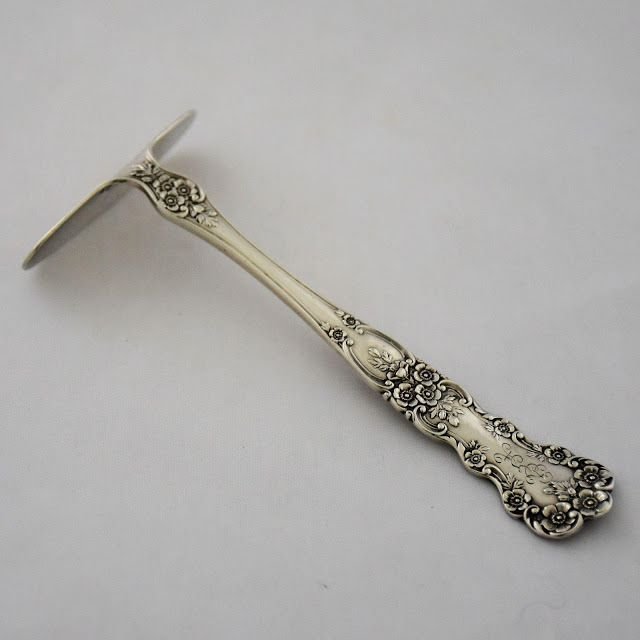
Picture:Food PusherBaby Food Pusher丨Picture from the Internet
This thing is not for the Second Brother, it is a “food pusher” for children – a pusher and spoon to help them easily push food onto their plates. …… Well, it’s true! It’s a Victorian er, table manners start with children!
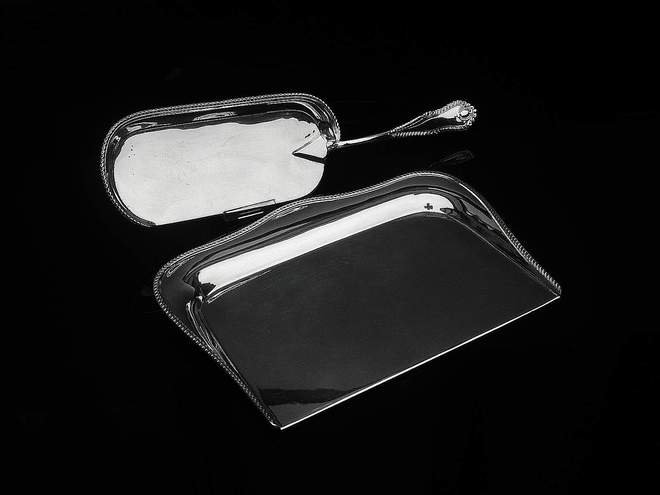
Picture:Crumb Scoop And Tray丨Picture from the Internet
This is a pizza spatula? NONONO, it’s a crumb spatula… In the 1850’s, servants used it to clean up bread crumbs and salad drippings from the dinner table… it seemed more elegant than using a dustpan and broom or a rag… (It’s amazing that servants had to be elegant to clean up the dinner table!)
In fact, these are only the tip of the iceberg of the Victorian silver tableware, there are spoon heaters, grape shears Grape Scissors, Knife Rest, Caddy Spoons Caddy Spoons …… limited to space (too much) really do not have the opportunity to appear. I picked up the chopsticks in my hands, can not help but fall into thought, why do people have to eat their fill of invention of so many cumbersome work on the sky, but it is indeed beautiful and good to see want to buy home to appreciate the tableware?
Do you have a lot of question marks, kids? Let me tell you ……
Actually, specialized yet targeted tools do work well!
In the experience of Kat Kinsman, antique flatware enthusiast and editor-in-chief of CNN’s food blog, her spoon with its wide, deep, curved bottom can be tilted to spread soup every time you have it, and the notch in the spoon filters out excess oil, so don’t be too fabulous for someone who is a stickler for good eating and a lot of demands.
In addition, it is true that there are some tableware that seem to be dispensable nowadays, but were very much in use at particular times in history. For example, sugar holders. During the Victorian period, sugar was a precious commodity, and those who had it would keep it in a locked sugar chest, the key to which could only be held by the hostess. Whenever tea was served or other occasions when sugar was used, the hostess used special little holders to distribute rare sugar cubes to her guests. While sugar cubes are common nowadays, silver sugar clips have become a special style of “elegant hostess afternoon tea” with a strong vintage flavor.

Photo: 19th Century Sugar Sprinkles and Sugar Clips Two-Piece Set 丨Picture from Bagpipe Art e-commerce platform
Moreover, no matter what time and place, the table is the most important social occasions, table utensils on the table all about the table host and the identity and status of the invitees.
Louis XV’s dinner table, there has been a solid gold “treasure ship”, which is loaded with spoons, napkins, salt shakers, test horn ……, Louis XV himself does not use, it has become a kind of ritual. Even if the king is not present, as long as you see the “boat”, men have to take off their hats, women also have to bow.
Not to mention the fancy assorted food boxes, napkins, candlesticks, baskets, and glazed chandeliers …… all serving to show off the king’s majesty.
Britain’s “dining style” was relatively recent, but the technique of elevating tableware to a status symbol was used with ease. In the Victorian era, when the British Empire reigned supreme around the world, this trend naturally became more and more intense.
It is attested that dinner parties of the time often included a minimum of twelve or more courses.
Imagine: each person’s cheese, fish, fruit, steak, chicken steak, lamb stew …… has to be accompanied by a different set of cutlery, each with its own butter knife, salt shaker, salt dish, and seasonal game utensils …… the table indicates, can it be okay?
What’s even more interesting is that this “unspoken rule of ZZ at the table” exists in every culture.
Wine lecturer Qi Shaoren said than a decade ago in France, today’s table can be much more simple, even the traditional French aristocratic families, no longer to tableware to show off their wealth, “instead of the banquet on the main chef’s loud name and all over the air transported over the rare seasonal ingredients.”
Nicolas Defrémont, who has been serving in the hotel world for many years, has switched things up by having his staff replace the appropriate specialized tableware at the right time, depending on what the guest has ordered (tableware-choice-phobes can breathe a sigh of relief). After all, more than the so-called dining etiquette, attentive service is the core competence of the restaurant.
And Arthu rInchInch, a consultant on the movie Gosford Hall, said, “Such over-the-top Victorian table furnishings, from chocolates spoons for drinking to eight different styles of special forks for broccoli, are a phenomenon of the middle class only.” — Rumored to be rarely used by royalty, a question mark that I can’t answer ……
Conclusion:
I’m sure you’ll say, isn’t the cutlery for the food? It’s the good food that counts, right?
Putting aside the element of social bragging, perhaps we can understand that in a particular context, abundant ingredients = enough spending power; exquisite tableware for each ingredient = both taste and sophistication; and a full complement of tableware for each guest = recognition and respect.
By the way, these complicated tableware sometimes have unexpected effects – according to legend, the French Bishop Richelieu once at the banquet table to reveal the true face of a liar, because he ate olives with a dinner fork, a farcical half will not use complicated tableware there is such an effect … … …
Views: 2